
The U.S. Army has ordered thousands of additional helmet sensors that can be used to record the severity of head movements and impacts during a combat-related blast or explosion. The sensors, called Headborne Energy Analysis and Diagnostic Systems (HEADS), are provided by BAE Systems and are revolutionizing the way data is captured, stored and retrieved to determine the effects that improvised explosive devices and other blunt impacts have on a Soldier’s head.
BAE Systems has fielded approximately 20,000 Headborne Energy Analysis and Diagnostic Systems sensors to the U.S. Army for use in detecting head and brain movements during combat-related blasts and explosions. (Photo: BAE Systems)
Under a new $16.9 million contract, BAE Systems will deliver the HEADS Generation II sensors by January of next year. This order will be in addition to approximately 20,000 sensors that are already in use.
“Traumatic Brain Injuries are known as a signature injury for Soldiers in Iraq and Afghanistan,” said Don Dutton, vice president and general manager of Protection Systems at BAE Systems. “The Army has an urgent demand for technologies that help identify individuals who may be in need of medical assistance for potential head and brain injuries. The data collected by HEADS during a traumatic event can be used to develop better protective equipment and for supporting further medical treatment.”
Positioned beneath the crown suspension pad of most combat helmets, HEADS allows the Army and medical practitioners to continuously measure and collect critical and potentially lifesaving data. These include impact duration, blast pressures, ambient temperature, angular and linear accelerations, as well as the exact times of single or multiple blast events. The placement of the sensor inside the helmet ensures that accurate measurements are achieved.
From late 2007 and into 2008, BAE Systems delivered more than 7,600 HEADS Generation I sensors to the U.S. Army and Marine Corps. Then HEADS Generation II was developed, introducing a wireless technology to download summary data of recorded events. Other enhancements to the sensor included a longer battery life, expanded pressure measurement and angular rate data.
The latest $16.9 million award is part of a five-year contract awarded in June 2010. This award brings the cumulative value of the contract to approximately $34 million.
BAE Systems is a leading provider of Soldier protective and load carrying equipment in the United States, producing a significant portion of the nation’s body armor, tactical vests, combat helmets and load carrying systems. Not only is the company focused on the design, development and production of leading edge survivability products, but its integration of advanced materials into manufacturing, rigorous product testing and field trials support the company’s focus on the men and women who serve in the armed forces.
Photos/Multimedia Gallery Available: http://www.businesswire.com/cgi-bin/mmg.cgi?eid=50334049&lang=en
Contacts:
Heather Russell, +1 602-643-7260
Mobile: +1
602-373-8625
heather.russell@baesystems.com
or
Neil
Franz, +1 301-838-6446
Mobile: +1 240-687-0127
neil.franz@baesystems.com
www.baesystems.com



